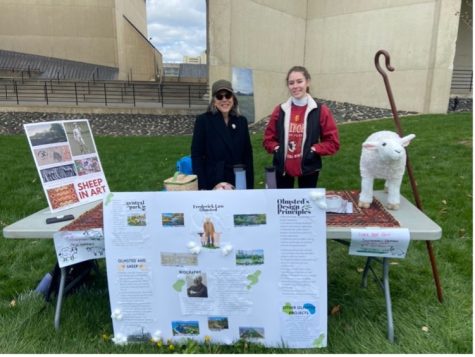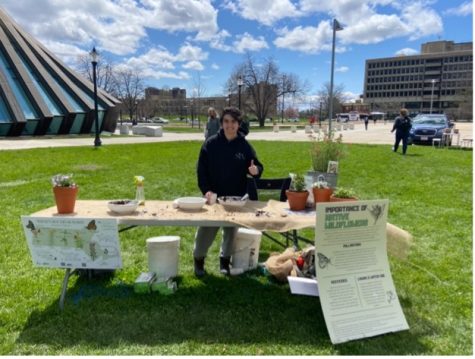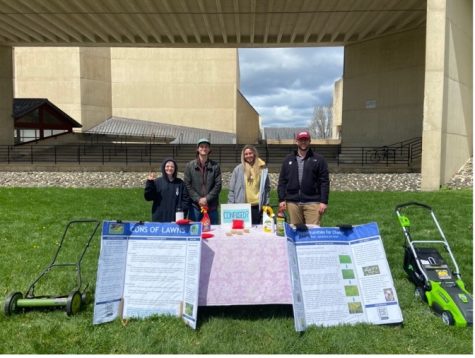Twelve sheep from the Hadley Farm turned heads on Tuesday and Wednesday on the lawn between the Isenberg School of Management and the Fine Arts Center at the University of Massachusetts. The sheep were guests on campus as part of the program Sustainable EweMass — an event meant to open a discussion about sustainable land management.
“It’s a cross campus collaboration between several classes and faculty members and the farmers from the Hadley Farm, which is the UMass farm,” Professor of Environmental Conservation and Geosciences, Britt Crow-Miller, explained.
“The idea is kind of to start a conversation about land management, and land management practices on campus and in our communities,” she continued.
Sheep are grazers by nature and have been used throughout history to manage grass—an example the event hoped to show of how land can be managed sustainably, without dependence upon fuels and pesticides.
Tables surrounding the sheep pen further explored different aspects of alternative land management methods. Most of the student-run tables were put together by UMass students in Crow-Miller’s Environmental Education class, where they’ve spent the semester envisioning what they want the future of both the campus and shared public lands around Amherst to look like.
“One of the points students wanted to make is that even small change is change,” Crow-Miller said. “We all feel overwhelmed with climate change, but making small communities feel change is still meaningful.”
The eight tables included projects from a tea station, featuring herbs grown in the University’s permaculture garden, to an ‘Imagining alternative futures’ station, highlighting both the sustainable practices of UMass and other colleges and encouraging passerby to draw how they envision an alternative to land use on campus.
An art history table, run by professor of art and architecture Meg Vickery, explored the influence of Frederick Law Olmsted and the impact of sheep on history and art. Tuesday, April 25, 2022, was Olmsted’s 200th birthday — part of the reason the program chose these days to welcome the sheep and present its students’ work.
Olmsted, an American landscape architect, designed Central Park in New York City, originally featuring sheep grazing in its grassy center. Vickery and her art history student, Amelia Ceballos, have spent the semester studying the cultural and historical aspects of sheep and wool, dating even further back than Olmsted. Ceballos additionally runs EweMass’ Instagram account, called @goewemass.

“Sheep have played a prominent role in art for millennia,” Vickery said, pointing to a poster that explained the connection of sheep to Mesopotamian culture.
“They’ve been important for land management for wool, textile, in particular. And it’s really interesting with sheep, because it’s not all about eating the lamb. It’s really about the wool and the products that they produce, the lanolin and the milk, and the wool,” she continued. Even famous pieces, like Michelangelo’s “David,” have connections to sheep — “David “was funded by the wool guild in Florence, Vickery added.
One table allowed students to make “seed balls” with clay, soil and native wildflower seeds, while another table served as a sensory reflection station. There, students could reflect on questions about land use and management and touch sheep’s wool and other natural items from around campus. This table focused on what Crow-Miller called the “nature connection,” which is something her class has learned about this semester.

“There’s a ton of research that shows when people are connecting with their environment and paying attention to their environment and spending time outside and even connecting with animals, there are lots of physiological benefits and cognitive benefits,” she said.
“So like, reduced stress and anxiety, better test performance, things like that. So the students really wanted to focus on using outdoor spaces to contribute to the well-being of students,” she continued.
Outdoor spaces on the University’s campus, as well as around the Amherst area are consistently caught on camera by the UMass Camera Trap Project — a project run by professor of wildlife conservation Kelly Klingler. The project boasted a table complete with printed out images of wildlife the motion-sensored cameras have witnessed over time, environmental science student Brian Vergato said.
“There are five of these camera traps directly around campus and then 40 in the surrounding campus area. So, all these photos there come directly from the camera traps or personal photos we’ve taken and then want to share,” Vergato explained. Crow-Miller additionally mentioned that bears, bobcats, possums, skunks and porcupines, among other lesser-known animals, have all been captured by the cameras on UMass’ campus.
A scavenger hunt table, which prompted students to explore campus and observe plants and animals in that space, aimed to enlarge their ideas of who and what constitutes the UMass campus. Encouraging the idea that the people living and taking classes on the campus are not the only things existing in that space, Crow-Miller said, is connected to the goal of increasing sustainable land management.

“It all adds up to a conversation about how to use our outdoor spaces in a way that really maximizes the well-being of our campus community, which includes students, faculty, staff, and all the other critters that that share the campus with us,” she said.
Devon Parsons, a student in the sustainability science graduate program, ran a table dubbed “Cons of Lawns.” The purpose of her table was to get a conversation going about alternative lawn care methods and to prompt people to question the typical land management that’s been in practice for over a century.

“Your classic pristine, green grass stems from, like, 100 years ago to class divides and systemic racism, which is wild to think about — that we still do land management, that that was the purpose of it,” Parsons said. She explained that those class divides have always sprung from the concept of how “weeds” are classified. Yards without weeds have been thought of historically as well-kept—but those well-kept lawns also take money, labor and time to create.
“We’ve been told what a proper lawn should look like, but why do we feel that way?” Parsons asked. Those cons include, then, traditional, unsustainable methods of using such lawn management.
“We’re kind of explaining the cons of lawns here and the environmental effects from gasoline dependence [and] dependence on chemicals like herbicides, pesticides and fertilizers,” Parsons said. While she recognizes that not every person can buy sheep to help trim their land, she believes there are small changes people can make to add up to big change.
“Like if people were to convert even one-third of their lawn to rewilding it, or letting it grow the way it wants to — without mowing it, without treatment — it could really increase pollination, which then brings more plants, more biodiversity, which then brings more pollinators, like it’s a really good, beneficial cycle,” Parsons explained.
This class served as a “living lab” for the students enrolled. They spent most of their class periods working on their projects, creating their goals and brainstorming what exactly they wanted guests to get out of the experiment.
It’s been especially important to Parsons that the class has pushed them to recognize the importance of educating people of all ages that “there are alternative methods to things we’ve always done. Even though it’s something that’s been done forever, it doesn’t mean it’s necessarily the right way to go about things.”
Ella Adams can be reached at [email protected] and followed on Twitter @ella_adams15.




















